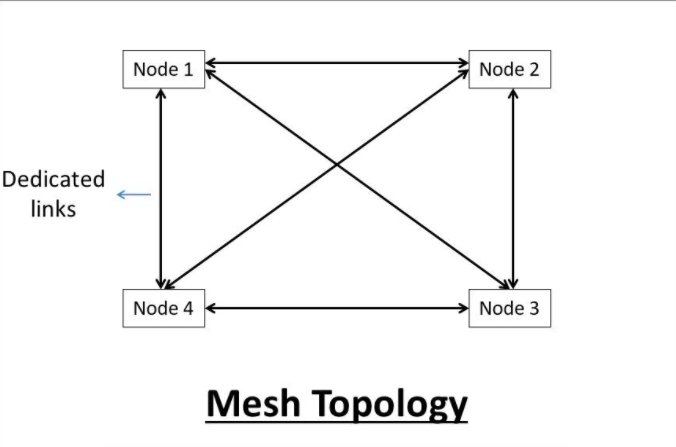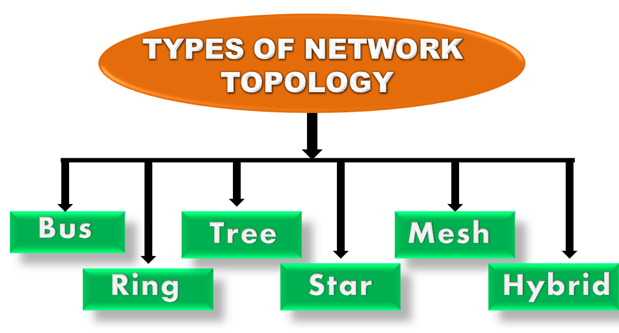In this article we will show you about difference between ring topology and mesh topology. below section will see you ring and mesh.
Ring Topology
In Ring topology, each node is connected to it’s left and right side nodes in which the information is travel from nodes to nodes in ring manner in one direction.There are also n links in ring topology like star topology, if there are n nodes present. In ring topology, to add a new node the entire connection must be broken down.

It is in a shape similar to a ring, in which every node is connected to only two neighbors. The messages move in only one and the same direction in this arrangement. In case any cable or device breaks away from the loop, then it can be a fatal problem for the entire network. All workstations are connected to each-other in such a way that they make a loop through which data is passed from one workstation to another easily.
Advantages of Ring topology:
- Easy Installation.
- Less Cabling Required.
- Reduces chances of data collision(unidirectional).
- Easy to troubleshoot(the faulty node does not pass the token).
- Each node gets the same access time.
- Data is quickly transferred & all data traffic is in the same direction.
Disadvantages of Ring topology:
- If a node fails, the whole network will fail.
- Slow data transmission speed(each message has to go through the ring path).
- Difficult to reconfigure(we have to break the ring).
- Disadvantage: If one workstation goes down, the other workstations will be effected.
Mesh Topology
In Mesh topology the nodes are connected to each other completely via dedicated link in which the information is travel from nodes to nodes and There are N(N-1)/2 links in Mesh topology, if there are N nodes.

There are mainly two types of Mesh:
Full Mesh: In which each node is connected to every other node in the network.
Partial Mesh: In which, some nodes are not connected to every node in the network.
In a fully connected mesh topology, each device has a point to point link with every other device in the network. If there are ‘n’ devices in the network, then each device has exactly ‘(n-1)’ input-output ports and communication links. These links are simplex links, i.e. the data moves only in one direction. A duplex link(in which data can travel in both the directions simultaneously) can replace two simplex links.
In this type of arrangement every node participating in the network is connected to every other node. However, this tends to be very expensive and difficult to implement. Multiple paths are can be used for transmitting a message. Due to the presence of dedicated links, it does not provide any traffic problem. All workstations are connected to each-other dedicatedly.
Advantages of Mesh topology:
- Dedicated links facilitate direct communication.
- No congestion or traffic problems on the channels.
- Good Fault tolerance due to the dedicated path for each node.
- Very fast communication.
- Maintains privacy and security due to a separate channel for communication.
- If a node fails, other alternatives are present in the network.
- Dedicated connection for all workstations.
Disadvantages of Mesh topology:
- Very high cabling required.
- Cost inefficient to implement.
- Complex to implement and takes large space to install the network.
- Installation and maintenance are very difficult.
- Disadvantage: The more wires required for each connection.
Topology and physical topology type:
What is topology?
In networking, topology refers to the layout of a computer network. Physical topology means the placement of the elements of the network, including the location of the devices or the layout of the cables. Logical topology maps the flow of data, regardless of the physical layout. In a computer network, there are mainly six types of physical topology, they are:
- Bus Topology
- Ring Topology
- Star Topology
- Mesh Topology
- Tree Topology
- Hybrid Topology
Difference between Ring Topology and Mesh Topology in below:
Ring Topology
- In ring topology, every node is connected to it’s left and right side nodes.
- The cost of ring topology is low.
- There are N links in ring topology, if there are N nodes present.
- In ring topology, the information is travel from nodes to nodes in ring manner in one direction.
- Ring topology is poor extensible.
- Ring topology is used in LAN.
Mesh Topology
- In mesh topology, the nodes are connected to each other completely via dedicated link.
- The cost of Mesh topology is expensive.
- There are N(N-1)/2 links in Mesh topology, if there are N nodes.
- In mesh topology, the information is travel from nodes to nodes.
- Mesh topology is also poor extensible.
- Mesh topology is generally suited for WAN.
I hope this article is helpful to you . Thank you!
